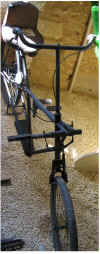A Visit to
The Musee de Velocipede
Cadouin, France
Cadouin is one of those typical small French villages - not really close to a big town, but no more than 4 or 5 km from the next village. There is an abbey, a church, and a relatively old covered market in the church square, which also houses the information office, a pottery, and a shop well stocked with local delicacies available for your buying pleasure.
We arrived in town right at 10 am, and after a quick ramble through the church, strolled 50 meters up the street, along the church complex, to the entry gate, which though closed, was unlocked. The museum appeared to be closed, but an upper window of the building next door flew open and an elderly lady asked if we wanted to see the museum. As soon as we said "Oui", another lady (who we assumed to be the museum director) came out and unlocked the museum door, turned on the lights, and collected our 5 Euro/person admission fee.
The director gave us a brief overview of the velocipede collection (in English), which is housed in three rooms and the single room that houses a collection of roller skates. The tour progresses from some of the oldest bicycle predecessors, including several ornately carved draisenes, through a number of direct drive bicycles and penny farthings, to several pre-1900 chain driven bikes. Historic bikes include a draisene from 1817, Jules Verne's velocipede, and a bike ridden in the first Tour de France. Unusual vehicles include early tricycles, alternative drive systems (linear, shaft, and cable systems) and various types of tandems.
As this museum is touted as having one off the most extensive
collections, I was interested to see that they had to represent the evolution of
the recumbent bicycle and found three examples. Unfortunately, due to
language difficulties (my lack of French and the director's lack of English), I
was unable to obtain no technical information about the recumbents, and only one
tidbit of gossip. Though there was a prohibition on photography, the
director was gracious enough to allow me to take a few photos
of the recumbents only (as she did not have any photos of them available for
sale).
The bikes all appeared to have been well-used, with significant weather exposure. All three would fall into the compact long wheel base school of recumbent bike design. The designs of two were similar and I believe they were made by Mochet (see below), We were not allowed to touch the bikes and were unable to determine any manufacturer's mark. Two of the bikes had signs with manufacturing dates.
Oldest of the three was dated 1923
The "1940" bike
appears to be similar to the Mochet Velocar that Francois Faure used to break
the world hour record in 1933 (see http://www.bicycleman.com/history/history.htm
and http://www.mochet.org/Liegerader/liegerader.html
[caution: in German]). Components were "modern": dual chainring
,
mid-drive and aerodynamic tailbox
.
Note also the light system.
Oddest of the three, was this bike,
tucked back in a corner and was identified as of German manufacture.. The
bike has a cable drive
but had a linear "push-pull" pedal system
 ,
rather than the rotating crank system used on the other bikes. When
I asked the director about the origins of the bike, the language barrier reared
its ugly head again, but she pointed out a photograph that was strapped to the
seat of the bike. The photo showed a man in a hat and suit riding the bike
in what appeared to be a public meeting. The guy looked familiar, and the
director identified the man as Hitler (but would not allow me to photograph the
picture).
,
rather than the rotating crank system used on the other bikes. When
I asked the director about the origins of the bike, the language barrier reared
its ugly head again, but she pointed out a photograph that was strapped to the
seat of the bike. The photo showed a man in a hat and suit riding the bike
in what appeared to be a public meeting. The guy looked familiar, and the
director identified the man as Hitler (but would not allow me to photograph the
picture).
If you're ever in Cadouin, check it out. Hours are 10 - 5, but don't stop by between 12 and 2, because everybody in France goes to lunch then and a lot of places are closed on Sunday, and Monday, and holidays, and sunny days, and rainy days, and generally whenever you want to go see something.

